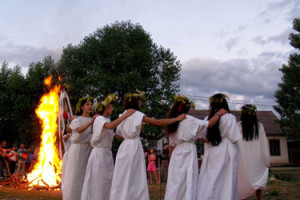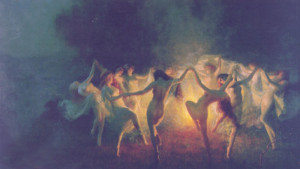 We find ourselves again in the middle of spring, at least those of us in the Northern Hemisphere. Where I live the sun is setting later and later, the trees are in full bloom and the first fruits of the season, mainly strawberries, are starting to come in by the bucket load. Admittedly my favorite season is autumn with its colors, cool breezes that are fragrant with the scent of drying leaves and abundant harvests, but as a spiritual person I understand the importance of being in touch with the full cycle of the year’s seasons. Spring is a time of regeneration and fertility and many cultures throughout the world hold rites and rituals to celebrate the aspect of renewal that is so visible this time of year. Today I thought we could look at some of the traditions and popular folklore surrounding this magical season of rebirth.
We find ourselves again in the middle of spring, at least those of us in the Northern Hemisphere. Where I live the sun is setting later and later, the trees are in full bloom and the first fruits of the season, mainly strawberries, are starting to come in by the bucket load. Admittedly my favorite season is autumn with its colors, cool breezes that are fragrant with the scent of drying leaves and abundant harvests, but as a spiritual person I understand the importance of being in touch with the full cycle of the year’s seasons. Spring is a time of regeneration and fertility and many cultures throughout the world hold rites and rituals to celebrate the aspect of renewal that is so visible this time of year. Today I thought we could look at some of the traditions and popular folklore surrounding this magical season of rebirth.
 As far back as pre-Christian Europe and probably since time immemorial, various cultures have observed rites and rituals to celebrate spring as the season or fertility and rebirth. Ancient Celts believed that the six months of the year starting with Beltane (May 1st) and ending with Samhain (October 31st) belong to the Mother Goddess who was the embodiment of fertility, motherhood and agriculture and the other months belonged to the Horned God who represented male energy, virility and hunting. In line with these beliefs, every spring, country dwellers would carry out numerous rituals to seek the blessing of the Mother Earth Goddess. It was common to pour offerings of milk and honey directly into the Earth to ask for an abundant harvest. As Christianity took root in Europe, the spring was chosen as the time to celebrate Easter, the Resurrection of Jesus, which to this day is filled with symbols of fertility and rebirth having been adopted from Europe’s pagan past. Also, in the Catholic Church, the month of May is sacred to the Blessed Virgin Mary and it is a tradition in many countries to bring lavish bouquets of spring flowers to her in churches. Modern Wiccans and other Neo-Pagans observe Beltane much in the same way as their Pagan ancestors did millennia ago and view it is the beginning of High Spring. My Wiccans friends have told me that in addition to being a celebration of fertility, Beltane is a time of light, playful energy during which faeries, elves and other Earth spirits are highly active.
As far back as pre-Christian Europe and probably since time immemorial, various cultures have observed rites and rituals to celebrate spring as the season or fertility and rebirth. Ancient Celts believed that the six months of the year starting with Beltane (May 1st) and ending with Samhain (October 31st) belong to the Mother Goddess who was the embodiment of fertility, motherhood and agriculture and the other months belonged to the Horned God who represented male energy, virility and hunting. In line with these beliefs, every spring, country dwellers would carry out numerous rituals to seek the blessing of the Mother Earth Goddess. It was common to pour offerings of milk and honey directly into the Earth to ask for an abundant harvest. As Christianity took root in Europe, the spring was chosen as the time to celebrate Easter, the Resurrection of Jesus, which to this day is filled with symbols of fertility and rebirth having been adopted from Europe’s pagan past. Also, in the Catholic Church, the month of May is sacred to the Blessed Virgin Mary and it is a tradition in many countries to bring lavish bouquets of spring flowers to her in churches. Modern Wiccans and other Neo-Pagans observe Beltane much in the same way as their Pagan ancestors did millennia ago and view it is the beginning of High Spring. My Wiccans friends have told me that in addition to being a celebration of fertility, Beltane is a time of light, playful energy during which faeries, elves and other Earth spirits are highly active.
Faeries and elves are what are known as elemental spirits. They are spirits of Earth, Air, Fire and Water that can at times manifest in physical form. I am not an expert in Faerie magic, but I do know many spiritual workers who work primarily with faeries. In Ireland and the British Isles, it was a tradition to place a dish of milk and a crust of bread on the back step or in the yard as an offering to the faerie folk or the little people in exchange for them watching over the land or not causing any harm. This tradition was carried to America by Scottish immigrants and remains popular in the Appalachian region of the United States, although today chocolate is often substituted for bread and milk. In Eastern Europe, particularly in Transylvania, there is also much faerie lore that is especially associated with the spring season. As the days grow warmer and longer, the faerie folk become more active. The night of June 23rd, Saint John’s Night, which in many magical traditions is a powerful night of spiritual manifestation as the veil between the spirit world and the physical world is quite thin, is heavily associated with faerie activity. In Romania this night is known as Noapte de Sânzienele or “Faerie Night,” and many herbs are gathered on this date because they are believed to be blessed by the faeries with curative and magical powers. Within the pantheon of faeries and Earth spirits that are abroad this time of year, there is a special caste of female faeries known as the Iele to whom many mysterious powers are attributed.
The Iele are an ancient and beautiful caste of spirits that are possibly carried over from Greek and Roman times. They appear along country roads at night and dance a traditional dance called the “hora” and it is said that the ground on which they dance is scorched and nothing will grow there afterwards. The Iele are unspeakably beautiful and their names are only known to a select few witches who can invoke them for both good and evil. “Iele” is a popular Romanian term meaning “them,” as their official names are a well-guarded secret. The Iele are particularly active in the springtime and peasants believe that they can be called upon after Pentecost to seek particular blessings as well as settle old scores. Well into the 20th century there was a secret society known as the Calusari whose members were recruited from villages across Romania that traveled across the countryside during the time of year when the Iele are most active and were believed to have the power to undo curses and spells cast by the Iele. The tradition of the Calusari largely died out by the mid-20th century and their traditional dances are reenacted for tourists today but I have heard rumors that the Calusari and similar secret societies exist and operate today in rural Romania.
I hope you have enjoyed this post about some of the spiritual beliefs concerning the spring season and I hope thing time of year is one of rebirth and renewal for you. As always I wish you peace, happiness and abundant blessings!